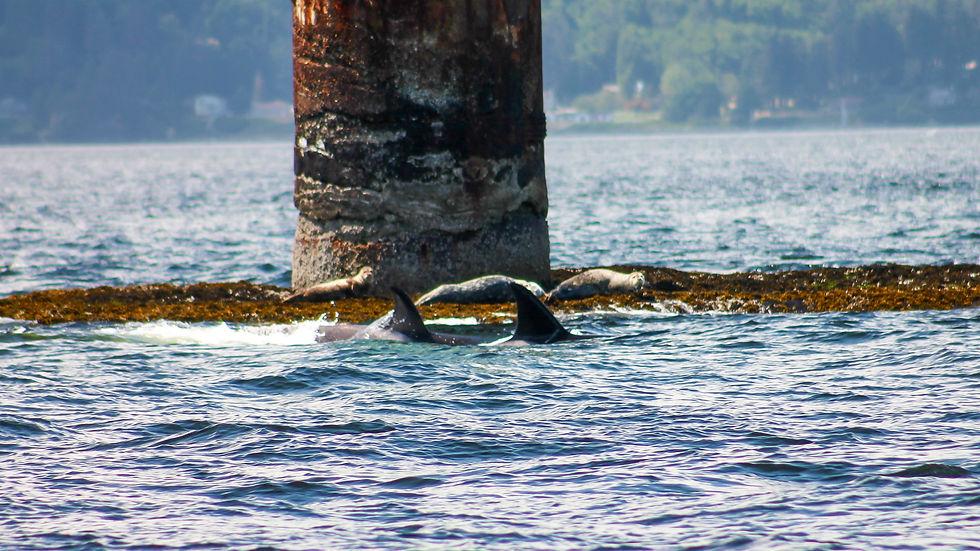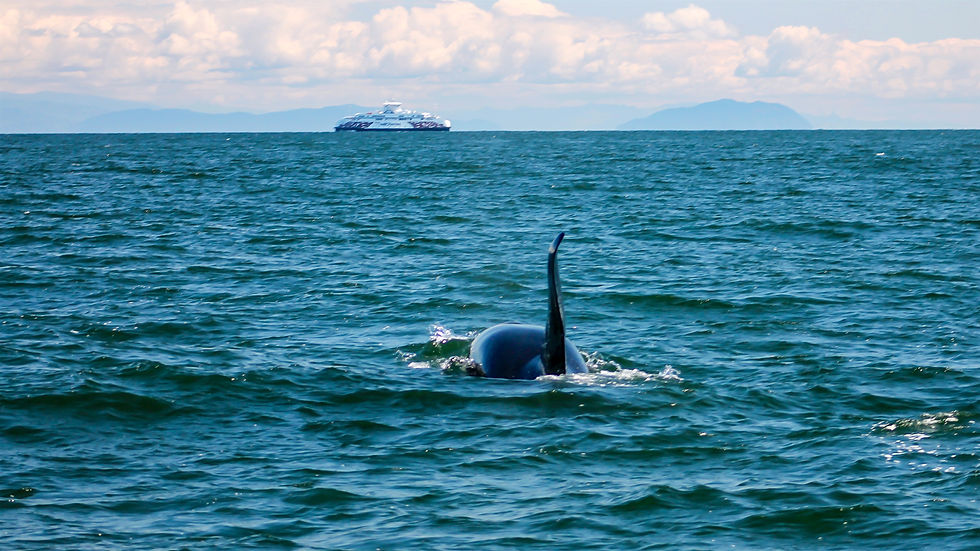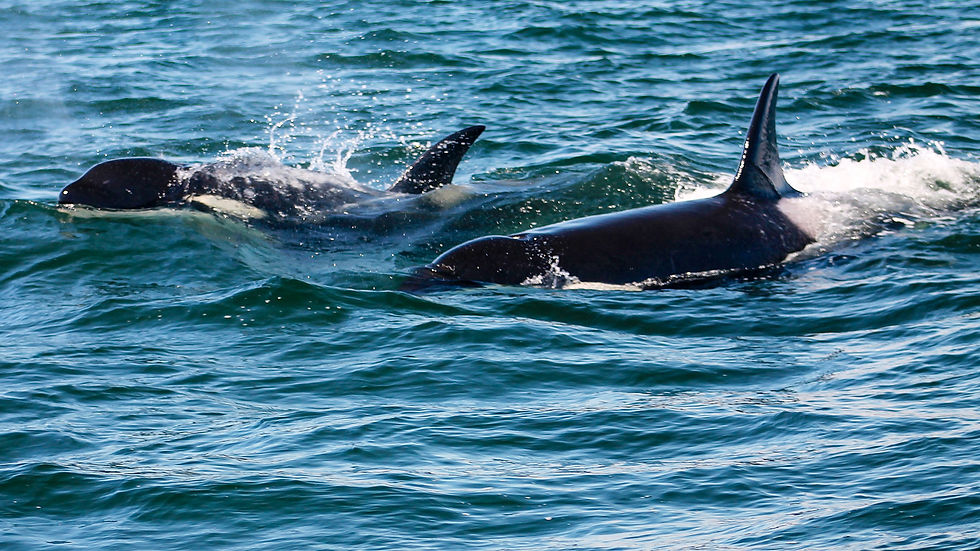When I was six years old, I saw the Free Willy movie. Orcas! Such a beautiful and majestic marine mammal that lives in families led by the oldest female, a matriarch. They are one of the top predators in all oceans and most seas.
Since then, I have known that I want to study killer whales when I grow up. Who cares that I lived in Central Europe, where the closest sea is a one-day ride in a car away, and we couldn't afford a trip even to see these animals.
My interests have expanded to other animals as years went by, but killer whales have stayed close to my heart.
The idea of my trip to Canada became more realistic many years later. One of the things I added to my To-do list was a whale watching tour, a tour to observe whales and other marine wildlife in their natural habitat.
In British Columbia, the whale watching season starts in April and ends in October, and even though I got used to almost persistent Vancouver rain, I waited for better weather.

The waters of BC are pretty rich in marine wildlife thanks to migratory routes of humpbacks (Megaptera novaeangliae), grey whales (Eschrichtius robustus), and minke whales (Balaenoptera acutorostrata).
You can see harbor porpoises (Phocoena phocoena) and Pacific white-sided dolphins (Lagenorhynchus obliquidens) by the coast.
Harbor seals (Phoca vitulina) and Steller sea lions (Eumetopias jubatus) lying on rocks; and killer whales (Orcinus orca), of course.
There are three types (sometimes considered as races, subspecies, or even species) of killer whales in the Northern Pacific ocean: residents, transients, or Bigg's and offshore.
Residents stay by the coast. They are fish-eaters (they prey primarily on salmon), live in large family groups called pods, vocalize a lot, and each family has its unique dialect.
Transients roam widely along the coast. They prey on other marine mammals (seals, other whales), their dialects aren't as complex, and they travel in small family groups (2-6 animals).
We don't know much about the third type because offshores travel vast distances in open waters. They feed on fish and probably on mammals and sharks. They congregate in huge groups with up to 200 animals.

It was cloudy with light rain when we left in the morning. What a surprise! After almost two months of sunny and hot weather (there were numerous wildfires across BC, whose smoke reached even Vancouver), it had to rain on the day we wanted to go whale watching.
Fortunately, when we were sitting in our jet-engine boat (to prevent propeller-caused injuries), the sky was getting clearer, and we were leaving Vancouver with a blue sky in front of us.
Whale watching is quite a popular attraction here. Thanks to that, we had almost 100% certainty of seeing whales. Over 40 vessels were monitoring the waters of the Salish Sea and the Strait of Georgia.
We went south to the Galiano Island, where after almost 2 hours, we found a female with one of her older calves circling a rocky island with a group of harbor seals. The whole scene was surrounded by at least four whale watching vessels no closer than the allowed 100 meters from the animals.

It was interesting to watch how the presence of killer whales randomly appearing and disappearing in waves had influenced the seals resting on rocks.
Most of them watched emerging dorsal fins, some of the seals ignored them, and some stayed in this dangerous situation close to the water. It was a waiting game that had, after several minutes, paid off.
With an excited "Wooooow" from almost everyone around me, a female's head emerged and, without any difficulties, grabbed one of the seals near the water, followed by her tail fluke splash as she probably tried to drown the seal.
A lesson in seal hunting techniques for a young orca and maybe a lesson for the seals. But I guess not…
Our boat reversed because we had got the information that there was a big group of transients near Point Roberts, and we were heading that way.
On our way, we passed around a tugboat with sand that seagulls used as a commute.
When we arrived at Point Roberts, we saw a group of other whale watching vessels following a group of approx. 15 killer whales.
This group had slowly broken into three family groups heading in different directions. We followed a group of 6 animals with two adult males with their typical triangular dorsal fin.

They were swimming peacefully next to us as they wanted. Orcas are faster than our boat, and they can hold their breath for about 20 minutes, so it is easy for them to disappear. And that was what happened at one moment.
Suddenly, they were nowhere to be seen. Our boat stayed on the course, and I started to think that either they had enough of us or they would appear just like that for fun somewhere directly in front of us. Fortunately, it was the second option.

Not even 10 meters in front of our boat, one of the males had appeared, crossing our path, followed by two other orcas. Apparently, they hadn't been informed about the 100-meter rule. Our boat slowed down. Now it was just us and one smaller vessel following the group split in two with us in the middle.
People on our boat didn't know where to go first, whether to the left or the right side. We were slowly following the group like this for about 15 minutes. When the part on our left almost stopped, we stopped.

Now, we were watching each other. They were swimming around just below the surface.
Sometimes they laid on their side, perhaps to see us better. At one moment, we could see just a fluke vertically out of the water, so-called lobtailing. We saw just a head vertically out of the water at another, so-called spy-hopping.
Unfortunately, in both cases, the animals were too close, or it had happened so fast to film it or even take a picture.

This whole encounter took only 20 minutes. After that, the orcas started moving again, and we had to head back to Vancouver. Our time on the sea was almost up.
We stopped near Iona Beach on our way back, where a group of harbor seals rested on rafted timber.
We returned after almost six and a half hours, but it was a fantastic experience, and I hope I will be able to see these majestic creatures again soon.


Comentários